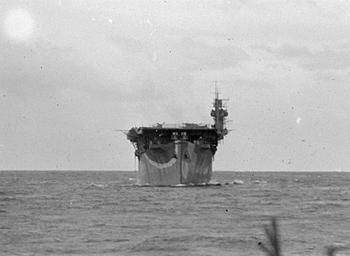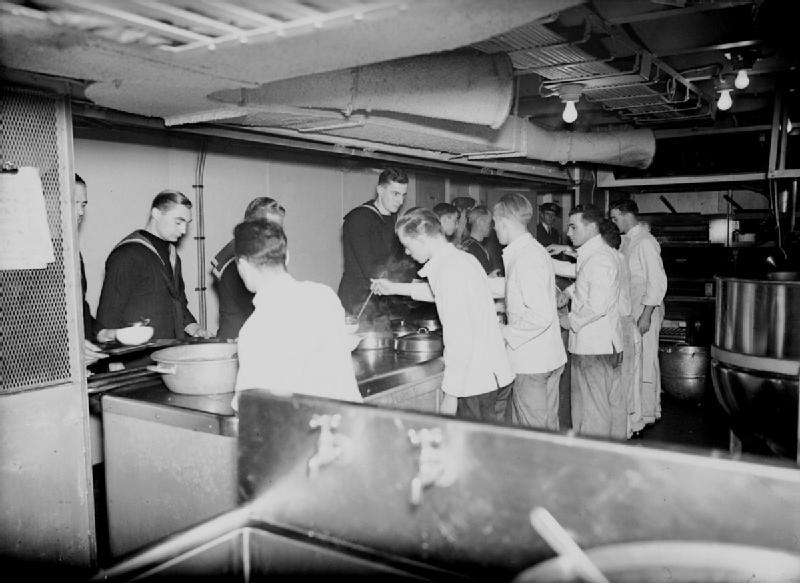On the 27th of March 1943, off the coast of Ardrossan, the HMS Dasher, an aircraft carrier, suddenly exploded in the waters between the town of Ardrossan and the Isle of Arran with the loss of 379 men.

The HMS Dasher was on escort duty protecting the North Atlantic corridor. On that fateful day, the 528 man crew of HMS Dasher had been conducting deck landing practice, while an Air Rescue Launch circled the ship, in case an aeroplane overshot the landing deck and landed in the water. Onboard the ship was carrying 75,000 gallons of fuel and enough aviation fuel for 15 aircraft, as well as 68 depth charges contained within the magazine

Nearby were four other vessels, the destroyer ‘La Capricieuse’, the radar training ship ‘Isle of Sark’ and two coastal vessels, the ‘Lithium’ and the ‘Cragsman’.
At 4.30pm with the deck landing practice completed, Captain Boswell announced to the crew that shore leave was being granted once they berthed at Greenock around 6pm. Around 4.42pm the ship suddenly shuddered and an explosion was heard, followed by a second massive explosion. The aircraft lift soared fifty to sixty feet into the air, before plunging into the sea on the port side. Immediately, every machine on the ship stopped and the ship was plunged into darkness. The lights came back on briefly.
Smoke and flames were seen rising from the aircraft lift shaft and the flight deck was buckled up to half the length of the hanger. Smoke and flames could be seen coming from splits in the starboard side of the ship.
With the ship settling by the stern, Captain Boswell ordered Lieutenant Commander Lane to find out what was happening. Lt. C. Lane made his way to the third deck which he found to be under three feet of water. Checking for any personnel, he made his way back to the upper deck which by then had water coming over it.
The two explosions had resulted in the complete destruction of the Fleet Air Arm mess deck, a violent fire in the after end of the hanger, a serious fire in the engine room, and rapid flooding throughout the ship.
Lt. C. Lane and the crew were trying to swing out the lifeboats, a task made more difficult as the bow of the ship was rising higher and higher, at which time the Captain ordered the crew to abandon ship.
With the bow of the ship rising rapidly the only Sea Hurricane not yet been strapped down, slid down the flight deck and fell into the sea.
The 528 man crew scrambled to reach safety through the passageways, guided only by the light of the flames. Sadly not everyone made it to safety. At 4.48pm with the carrier almost vertical, it sank into the sea, accompanied by the screams of the dying men who were trapped below decks, six minutes after the first explosion.
Those who had made it off the ship weren’t out of danger. Thick black fuel oil leaking into the sea from the ship’s ruptured tanks suddenly caught fire and flames rushed across the water, trapping many, who tragically burned to death. Those not caught by the flames had to swim or use Carley floats to get to the safety of the waiting ships, where they were given blankets.
A massive sea rescue operation was immediately instigated. The two coasters immediately made their way to the scene of the disaster, but due to the flames and smoke could not get close enough.
The 149 survivors were brought to HMS Fortitude, the military base at Ardrossan Harbour. A blanket of secrecy was immediately imposed by the Royal Navy. Those who had survived were allowed to inform their relatives that they would soon be home but were otherwise forbidden to reveal any information about the accident. The beach at Ardrossan was immediately marked as out of bounds to the public and was constantly patrolled by Royal Navy personnel who recovered the bodies being washed ashore.
Information on the H.M.S. Dasher disaster was not declassified until 1972 and handed over to the Public Records Office, now known as the National Archives in Kew, London.
The surviving sailors remained at Ardrossan until after the funeral.
Onboard the radar training ship ‘Isle of Sark’, training instructor Alex Buchanan captured photographs of the sinking ship with his box camera.
Lifeboats from the other ships rescued the survivors and the bodies of those who had died.
Three hundred feet above the Arran hills, William McAuslan of the Royal Observer Corps had an eagle view of the drama unfolding on the Clyde.
At HMS Fortitude (Ardrossan Harbour) they received a distress signal which read “prepare for a large number of casualties”. Action was taken immediately with a large number of Minesweepers departing from the harbour and speeding to the site of the disaster to aid with the rescue effort.
The sudden departure of so many ships alerted the residents that something was up, and many made their way to the top of Castlehill to see what was going on.
At the local cinemas, a message was flashed across the screens “all civil defence and first aid personnel report to posts immediately!”. Around fifty ambulances, ambulance trailers and first aid vehicles arrived at Ardrossan Harbour bearing doctors, nurses and stretcher bearers.
The injured and were taken to the Royal Navy Sick Bay at 8 South Crescent, Ardrossan, the first aid post in Saltcoats, Ballochmyle Hospital and the deceased to the morgue at Harbour Street, Ardrossan.
Those not requiring medical attention were taken to the Royal Navy base in Glasgow Street and the Officers were taken to the Eglinton Hotel in Princes Street. Sadly of the 528 man crew, only 149 men survived.
19 bodies from the HMS Dasher’s crew were brought to Ardrossan Harbour, 12 of whom were buried in Ardrossan Cemetery.
FUNERAL SERVICE
Twelve of the bodies brought to Ardrossan Harbour were buried in Ardrossan Cemetery. On the day of the funeral, a procession made its way to Ardrossan Cemetery. The twelve coffins, each draped with the Union Jack, were transported to the cemetery on two open-back lorries, followed by the cars carrying the relatives of the deceased, behind which were the firing party and the Naval band who played the Death March, with the drums being muffled. At the rear were representatives from the Royal Navy and the Women’s Royal Navy Services.
Shops along the funeral route were closed and people lined the streets watching in silence as the funeral procession under the command of Captain J. L. Fields proceeded slowly and with great dignity to Ardrossan Cemetery. At the cemetery as each coffin was laid to rest a volley of shots was fired overhead. At the end of the ceremony the Naval band played “Colonel Bogey” as they quickly marched from the cemetery
Buried at Ardrossan Cemetery were
Sub-Lieutenant Trevor Victor Buxton, aged 25, Royal Navy Volunteer Reserve
Sub-Lieutenant William Pratt Haughie, aged 25, Royal Navy Volunteer Reserve
Lieutenant Ralph Carnac Baker Stallard-Penoyre, aged 29, Royal Navy
Able Seaman Ernest Charles Costar, aged 23. Royal Navy, Service No. C/JX 190282.
James Crawford, Greaser, aged 29. Naval Auxiliary Personnel (Merchant Navy) Service No. R/180150
Cecil John Davis, Ordinary Telegraphist, aged 21. Royal Navy, Service No. C/JX 271890
Alexander Grieve – Flight Sergeant, Royal Air Force. Service No.564019 – aged 28
James Kane – Able Seaman, Royal Navy. Service No. C/SSX 18806 –
Arthur Charles Lawrence – Greaser, Naval Auxiliary Personnel (Merchant Navy) Service No. R/191743, aged 23
Thomas Joseph Martin – Able Seaman, Royal Navy. Service No. C/JX 168035 – aged 24
John Melville – Ordinary Coder, Royal Navy. Service No. C/JX 361352 – aged 37
Jack Stephen Wright – Able Seaman, Royal Navy. Service No. C/J 110766 – aged 34
Also buried at Ardrossan Cemetery with full Naval Honours was 20-year-old Air Mechanic who died on 09 April 1943, as a result of the severe burns he had sustained to his face, hands and chest. He died with his parents at his bedside.
Air mechanic William McDonald digging in his kitbag for his shaving gear when he was blown through a hole in the side of the ship, and landed 400 yards away in the water still clutching his kit bag.
At Greenock Cemetery the Royal Navy held a similar ceremony for six men who were buried with full military honours. They were:
Lieutenant Fleetwood Elwin Price, Royal Naval Volunteer Reserve, aged 42
William Gillies – Leading Writer, Royal Navy. Service No. D/SR 16610 – aged 24
Harry Harper – Able Seaman, Royal Navy. Service No. C/JX 260671 – aged 33
Richard Liddle – Ordinary Seaman, Royal Navy. Service No. C/JX 374403 – aged 27
Ronald Neath – Leading Radio Mechanic, Royal Navy. Service No. P/MX 10061 – aged 20
George Harold Morris Percival – Ordinary Seaman, Royal Navy. Service No. C/JX 359516 – aged 29
Sub-Lieutenant John Lyle McFarlane, Royal Naval Volunteer Reserve, aged 21 was privately buried at Greenock Cemetery by his family
Also privately buried were
Sub-Lieutenant John Ian Russel Walker, aged 21 – Royal Naval Volunteer Reserve – buried at Mearns Cemetery, Glasgow
Leading Seaman Archibald Craig, aged 23 – Royal Navy. Service No. P/JX 212188, buried at Hawkhead Cemetery, Paisley
Able Seaman Sylvester Woolaghan, aged 23 – Royal Navy. Service No. C/JX 212950, buried at Frizington (St. Joseph’s) Roman Catholic Cemetery, Cumbria
Of the 379 men who died that day 338 are remembered on War Memorials in England. 157 at the Chatham Naval Memorial, Kent; 92 at the Lee on Solent Memorial, Hampshire; 60 at the Liverpool Naval Memorial; 14 at the Portsmouth Naval Memorial, and 12 at the Plymouth Naval Memorial. Two of the RAF pilots who died that day, Sergeant Roger Leonard and Corporal Stanley Muirson Parks are remembered on the Air Forces Memorial at Runnymede, Surrey.
Incredibly at 8pm that same night the Nobel Explosives ship, the ‘Lady Dorothy’ carrying 250 tons of high explosives passed over the sight of the disaster.
It was ascertained by the Board of Enquiry that the source of the explosion had not come from an external source and determined that the first explosion had occurred in either the depth charge magazine or the main petrol stowage area.
In 1993 a memorial was erected to those lost on the HMS Dasher in Ardrossan.
On 20 June 2000 a memorial plaque was laid on the flight deck of H.M.S. Dasher by diver Mark Reeves which read “Dedicated to the memory of the 379 men who perished when HMS Dasher blew up and sank on 27th March 1943.
Further Reading
HMS Dasher at the Royal Navy Research Archive
HMS Dasher at Canmore
HMS Dasher at Wrecksite.eu
Graves can be searched at Commonwealth War Graves Commission